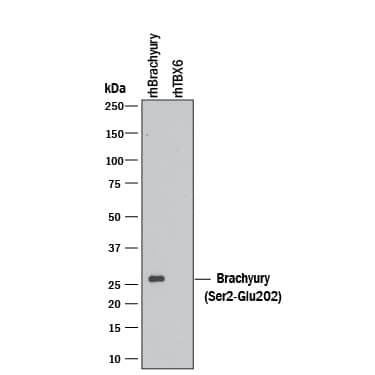Mouse TRAIL/TNFSF10 Antibody Summary
Pro118-Asn291
Accession # P50592
Customers also Viewed
Applications
Mouse TRAIL/TNFSF10 Sandwich Immunoassay
Please Note: Optimal dilutions should be determined by each laboratory for each application. General Protocols are available in the Technical Information section on our website.
Preparation and Storage
- 12 months from date of receipt, -20 to -70 °C as supplied.
- 1 month, 2 to 8 °C under sterile conditions after reconstitution.
- 6 months, -20 to -70 °C under sterile conditions after reconstitution.
Background: TRAIL/TNFSF10
TNF-related apoptosis-inducing ligand (TRAIL), also called apoptosis 2 ligand (Apo2L) for its similarity in sequence, structure, and function to Fas Ligand/Apo1L, is a 33‑35 kDa type II transmembrane glycoprotein of the tumor necrosis factor superfamily, designated TNFSF10 (1‑3). Mouse TRAIL cDNA encodes a 17 amino acid (aa) N-terminal intracellular domain, a 20 aa transmembrane domain and a 253 aa extracellular domain. Like most TNF family members, TRAIL is bioactive as a homotrimer (1). Unlike other TNF family members, a zinc ion complexed by human Cys 230 (mouse Cys 240) of each of the three monomers is critical for structural stability (4, 5). Either transmembrane or cysteine protease-released soluble sTRAIL induce apoptosis of many transformed cell lines, but rarely of normal cells (3, 6). Accordingly, TRAIL is suggested to have a role in tumor surveillance (1). Mice with genetically disrupted TRAIL have defective thymocyte apoptosis, creating faulty negative selection and some increased susceptibility to induced autoimmune diseases (7). In humans, TRAIL controls apoptosis of erythrocyte precursors and sTRAIL is inversely correlated with hemoglobin (1, 8). TRAIL transcripts are constitutively expressed in a variety of human (and presumably mouse) tissues and mononuclear cells (2, 3). Only one of two receptors that transduce apoptotic signals in humans is found in the mouse (TRAIL R2/DR5 but not TRAIL R1/DR4) (1). Mice express TRAIL receptors DcTRAIL R1/TNFRSF23 and DcTRAIL R2/TNFRSF22. These receptors lack death domains, but differ in structure from human regulatory receptors TRAIL R3 and TRAIL R4 (9). Osteoprotegerin has been identified in humans as a TRAIL receptor, but binding in mouse has not yet been demonstrated (1, 10). Mouse TRAIL shows 85% aa identity with rat TRAIL and 70% aa identity with human, bovine, and porcine TRAIL within the TNF homology domain (aa 118‑291).
- Zauli, G. and P. Secchiero (2006) Cytokine Growth Factor Rev. 17:245.
- Wiley, S.R. et al. (1995) Immunity 3:673.
- Pitti, R.M. et al. (1996) J. Biol. Chem. 271:12687.
- Bodmer, J.L. et al. (2000) J. Biol. Chem. 275:20632.
- Hymowitz, S.G. et al. (2000) Biochemistry 39:633.
- Sedger, L. M. et al. (2002) Eur. J. Immunol. 32:2246.
- Lamhamedi-Cherradi, S.E. et al. (2003) Nat. Immunol. 4:255.
- Choi, J.W. (2005) Ann. Hematol. 84:728.
- Schneider, P. et al. (2003) J. Biol. Chem. 278:5444.
- Emery, J. et al. (1998) J. Biol. Chem. 273:14363.
Product Datasheets
Citation for Mouse TRAIL/TNFSF10 Antibody
R&D Systems personnel manually curate a database that contains references using R&D Systems products. The data collected includes not only links to publications in PubMed, but also provides information about sample types, species, and experimental conditions.
1 Citation: Showing 1 - 1
-
Tumor necrosis factor-related apoptosis-inducing ligand translates neonatal respiratory infection into chronic lung disease.
Authors: Starkey M, Nguyen D, Essilfie A, Kim R, Hatchwell L, Collison A, Yagita H, Foster P, Horvat J, Mattes J, Hansbro P
Mucosal Immunol, 2013-09-18;7(3):478-88.
Species: Mouse
Sample Types: Tissue Homogenates
Applications: ELISA Development (Capture)
FAQs
No product specific FAQs exist for this product, however you may
View all Antibody FAQsIsotype Controls
Reconstitution Buffers
Secondary Antibodies
Reviews for Mouse TRAIL/TNFSF10 Antibody
There are currently no reviews for this product. Be the first to review Mouse TRAIL/TNFSF10 Antibody and earn rewards!
Have you used Mouse TRAIL/TNFSF10 Antibody?
Submit a review and receive an Amazon gift card.
$25/€18/£15/$25CAN/¥75 Yuan/¥2500 Yen for a review with an image
$10/€7/£6/$10 CAD/¥70 Yuan/¥1110 Yen for a review without an image















